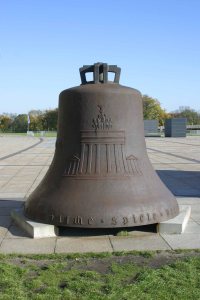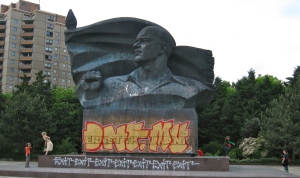This is an excerpt from a paper that we will present in Izmir, Turkey, next week as part of the European Workshops in International Studies; we are in the social theory section (big surprise) organized by Benjamin Herborth, University of Groningen, and Kai Koddenbrock, University of Duisburg-Essen.
(left-over Nazi bell from the ’36 Summer Olympics)
On the failures of constructivist language for our purposes.
In each case, the materiality of the object contributed to its fate. There were clear economic, cultural, and logistic costs and considerations associated with our objects under study being de-constructed, re-constructed, or, for lack of a better term, un-de-constructed, or, put simply, left. Upon even modest reflection, the available constructivist vocabulary seems to fail us in these moments; primarily developed for understanding how things are to be built, we find it difficult to utilize such language for encapsulating and illuminating the processes associated with the allowable decay resistant materials and the slow unintended or unattended-to wasting-away of durable objects.
The only apparent option is to capture attempts at (re)framing — discursively, symbolically, but not practically — the (re)appropriation of monuments in official and unofficial accounts of history. People “make sense” of these ruins, so the classic constructivist interpretation goes. And as soon as they stop or do not care any more there is nothing left to say. That is exactly what Foucault bemoaned when he complained about a historiography that turns monuments into documents. One can easily see that his complaint does not only hold for historical accounts, but for social sciences looking at contemporary issues as well: if we cannot find someone who makes sense of something, then that something simply does not count. But as our cases show: that does not make these massive pieces of concrete, bronze, and iron go away; it does not even leave them untouched. Even when people do not care, forget, or even ignore: the stuff left-over by former state projects stays and shapes what can and cannot be done with it.
(Soviet War Memorial)
As we view the cases, those Soviet War Memorials constitute a kind of classic form of international relations, one held together by international treatise and inter-governmental agreements regarding the conditions of maintenance for the sites. Based on agreements, the materiality of the sites are not to be marred. The formerly-Nazi Olympic bell constitutes another form of international relations that is de facto, meaning, the bell’s unearthing and repositioning outside the Olympic stadium is not the outcome of treaties with another nation or the result of any linger agreement from former German governments. The bell’s durable material hardly needs to be willfully maintained; however, to remove it would require a considerable quantity of will, both economic and cultural. As the international stage observes how Germany will learn to deal with its past, the irremovable bell lingers-on in public view with only modest material transformation, which recognizes without celebrating the past. How Germany relates to the material residues of past governments becomes a form of international relations.
(perpetually graffitied Ernst Thälmann Park memorial bust)
The Thälmann bust appears to us as an example of international relations unquestionably shaped by materiality, or, put another way, as a standing example of material international relations. The costliness of its decommissioning outweighed so greatly the will and coffers of the Berlin city commission that, despite being selected for removal on the basis of historical value, the monument endures (Ladd,1997: 201). Unlike the Soviet War Memorials, the the Thälmann bust is not vigorously maintained; however, it has also not been disabled like the Berlin Olympic bell. The operant or public identity of the memorial in Ernst Thälmann Park is one of a graffitied material behemoth. Creative urban artists embellish the statue and only occasionally and without ceremony is hulk washed of the ongoing alterations that it is subjected to from the public.
In sum, the Soviet War Memorials endure for classical reasons of international relations; the Olympic bell endures, irremovable but intentionally altered so that it no longer bears the inscription of a past government and it is incapable of expressing its material purpose to ring; though its removal was approved by a commission whose sole purpose for convening was to determine how the Berlin cityscape would be selectively altered, through its hulking materiality the Thälmann bust endures in a state of semi-permanent but allowable vandalization.
As we reflect on the monuments to a former age, we think of commentary on the repurposing of the Berlin Olympic stadium. Walter’s (2006: xiii) reflects in an extended passage from a perhaps little-read preface:
“Whereas other Nazi edifices such as the rally grounds at Nuremberg are rightly abandoned, this is a building still very much in use – even playing host to the 2006 World Cup final. Although some argue that a structure so closely associated with the Nazi period should not be used, it would seem churlish (and uneconomical) to abandon so handsome and vast a building. In 1936 it may well have been regarded as an architectural embodiment of the waxing power of the new German Reich, but in 2006, the seventieth anniversary of the Nazi’s Olympics, it stands as a symbol that Germany has the ability to come to terms with its past. Why should it not be used? What harm does it do? The shape of the Olympic Stadium does not register as a symbol of evil in the same way as the infamous entrance to Auschwitz, with its railway lines converging to pass under its all-seeing watchtower. The stadium may well not be free from guilt, but like many associated with the Nazi regime, it does not necessarily deserve the death penalty.”
The language used in the passage above to execute an old stadium produces a clear image in the mind; however, do not mistake it as a heartfelt call from the inner-circles of STS to adopt a relational materialist approach to the symmetrical depiction of humans and nonhumans. Still, there is a kernel of insight worth coaxing into germination.
Sentencing a stadium to death would not only be deemed mean-spirited and irrational by Walters, the implication is that one way to deal with international relations (even with old dead states, like the Nazi state) is through the material relations — what Barry calls “material politics” — of monumental spaces such as architect Werner March’s, on Hitler’s orders, grand Olympiastadion staged in the Reichssportfeld (which was built on the foundation of the previous Olympiastadion from the aborted 1916 Games in Berlin). By material politics, Barry conceptualizes processes by which the material world gets drawn into a dynamic relationship with politics; the material world, as it happens, is an important resource for the practical conduct of politics. In STS, Barry’s approach can be contra-positioned with the old adage that “artefacts have politics,” by which Winner (1986) means that technologies have politics as a quintessential part of their design or contextual situatedness.
Returning to our main line of discussion, Barry’s project is explicitly about dealing with a project under construction, in his case, laying a rather large oil pipeline, while our is about dealing with a project long-since constructed. Barry’s case is emergent; our cases are left-over. For us, this sometimes means intervention or decommission and other times it means preservation or transformation, either way, the state must relate to these residues of past states. While the constructivist language common to STS accounts serves Barry well, we find it wanting and search for alternatives more suitable for conceptualizing and describing decay amid durability and the state of being left behind.



cheers!
LikeLike
doing STS of STS sounds like a good plan of action to me, we (theory-mongers) keep switching subjects; subalterns, diasporics, hybrids, cyborgs, objects, etc but I’m not sure that we have really shifted gears yet, will keeping chewing on it…
LikeLike
No harm in the slightest. Coming from the subject or the author is a good and valid concern. Does the subject compel me or am I forcing my reading onto the lived-world? Part of the discussion really must also be a consideration of the literature. In my experience — and this may be spell the demise of humanities-based disciplines, but it is also why we call them traditions — the ideas that are of use to academics exist (i.e., gain publication and notoriety) often only if they build on past scholarship or provide a viable alternative to, let’s say, business-as-usual. In so far as that is true, must that is supposedly epistemological is also aesthetic. While scholarship is not all fashions and trends, the arguments we make — for example, mine in this post — may be suboptimal (i.e., to find an alternative to constructivist language) and (most certainly) I claim the alternative (i.e., constructivist thinking) to be no less suboptimal, they are still at least engaged in a tradition and way of producing scholarly accounts (I feel like I’m doing an STS of STS now). Regarding the other point, about the troubling quality of the “always forever reassembling” principle: let me be clear that at the most basic level of analysis and experience, I am confident that you are correct, “always forever reassembling”. However, one of the things that I’ve been working with more and more lately is looking to the empirical world for answers not only to our academic questions, but also as a source of re-thinking our old academic traditions. I’m not sure if that translates clearly in this comment right now, but, well, here is a sentence that I am working on right now in a new paper: “There is perhaps not a greater lesson for state theorists to learn than that we must increasingly look to the lived-world to supply us with their state theories rather than assume the superiority of the ones we have inherited through training, or, far worse and unacceptably vain, the theories we have penned.” Perhaps that begins to get at my point, in this case, if we are to study state theory, somebody could say all day (and some scholars have) that “the state is not an actor” (and they would be right in a number of ways); however, that simply does not change the reality that the state WILL be depicted as an actor, for example, in news stories the following day; does that not at least in some way make the state an actor? I don’t mean that in any essentializing way (meaning, that I would now conclude that all state are actors at all times, for example). After all, in order to challenge to the actor-state model, the contrarian must invoke it and frame it as believable enough to function as a viable alternative to his or her replacement model.
LikeLike
sorry not questioning your take on the field or your desire to offer a correction of better fit, just trying to get a grip for myself on what the alternative is that yer suggesting and if it comes from the subject or(and?) the author.
All a matter of degrees of difference(s) but in so much as we are always manipulating our ways thru shifting environs/assemblages not sure how I see a categorical/philosophical alternative for human-beings to re-assembling as we go for present purposes, do you, and why troubling?
LikeLike
Answer: I think so and I know so. I think that there is something special about “dealing-with” pre-existing materials not constructed by the entity that comes to grips with them (esp. when that entity is a state and their activities are viewed publicly as a sort of de facto material international relations); however, I have not yet proven that; alternatively, I am confident that the literature on constructivism and the STS literature more generally at least since the mid-1980s has adopted a constructivist tone (sort of the way that almost all sociology is closet functionalism); this, I can demonstrate. Your point about “always already reassembling without start or end” seems reasonable and there are moments where I agree with it purely in my mind; however, I am quite confident that that is a minority view and that our theories need to take into account that the actors we study likely do not share our penchant for being analytically and technically correct. What’s more, I am worried that a claim like that (of perpetual reassembly) strikes me as having no alternative, which is troubling, but in a different direction.
LikeLike
ok but do un-de-constructed things make particular/unique claims on us or have they just not been foregrounded?
as a kind of instrumentalist i don’t find a real difference between construction and deconstruction, all acts of reassembling for present purposes/interests, no?
LikeLike
it boils down, I suppose, on the idea that constructivist thinking, which is at the core of much STS these days (given the Pinch and Bijker 1984 base), is an emphasis on “constructing” things and then another (but smaller) emphasis on “de-constructing” things. The issue is how to discuss seriously “un-de-constructed” things?
LikeLike
may have just needed another read (or cup of coffee) but I’m not entirely clear is this about how we relate to left-overs (if you will) or more about trees falling in the woods? and if about left-overs than are our relations to them so different from the subjects/objects of other endeavors, is there a sort of kantian emphasis on what exceeds our uses/purposes a kind of trashy-Sublime?
http://the-archipelago.net/2014/05/07/david-gissen-on-the-non-greenness-of-nature-debris-dust-and-other-atmospheric-architectures/
LikeLike